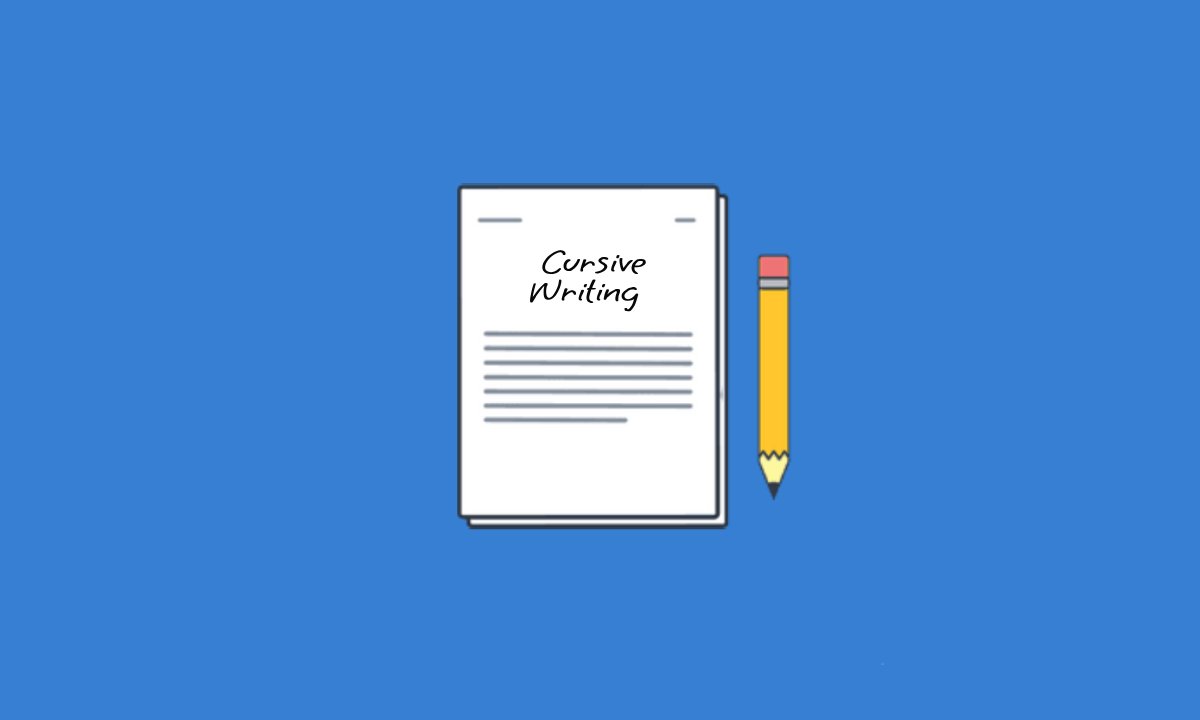What is Cursive Writing?

Cursive writing is a style of penmanship in which letters are connected in a flowing manner, often for the purpose of making writing faster. This script is characterized by the fluid movement of the hand, where each letter is connected to the next, typically with a single stroke, rather than being written as separate entities as in print or block writing.
How to Learn Cursive Writing?
Below is a step-by-step guide to help you learn cursive writing effectively:
Understand the Basics of Cursive Writing
Before starting, familiarize yourself with the cursive alphabet. Cursive writing involves connecting letters in a flowing, continuous manner, which differs from print writing.
Gather the Necessary Materials
Cursive Writing Guide: Obtain a guidebook or printable sheets that show cursive letters and their proper formations.
Lined Paper: Use lined paper to help maintain consistent size and spacing of letters.
Pens or Pencils: Use a smooth-writing pen or a pencil with a good eraser for practice.
Practice Basic Strokes
Cursive writing is composed of basic strokes. Practice these strokes to get comfortable with the motion:
Upward Strokes: Start at the bottom line and move upward.
Downward Strokes: Start at the top line and move downward.
Curves: Practice both undercurves and overcurves.
Loops: Practice both upward and downward loops.
Learn Lowercase Letters
Start with lowercase letters, as they are used more frequently:
Group Similar Letters: Begin with letters that have similar shapes. For example:
a, c, d, g, q: These all start with a circular motion.
i, u, w, t: These involve simple upward and downward strokes.
b, f, h, k, l: Practice loops and taller letters.
m, n, v, x, y, z: These involve a mix of loops and upward strokes.
Learn Uppercase Letters
Uppercase cursive letters can be more complex, so take your time with them:
Start Simple: Begin with simpler letters like A, C, E, L, and O.
Progress to Complex Letters: Move on to more complex letters like B, D, F, G, and Q.
Connect Letters
Once you’re comfortable with individual letters, start practicing connecting them. Start with simple words, focusing on maintaining a fluid motion between letters.
Practice Regularly
Consistency is key to mastering cursive writing. Dedicate a specific amount of time each day to practice. Start with 10-15 minutes a day and gradually increase as you become more comfortable.
Use Cursive in Daily Writing
Incorporate cursive writing into your daily activities. Write shopping lists, journal entries, or letters in cursive to reinforce your skills.
Analyze and Adjust
Regularly review your writing. Look for areas where you can improve in terms of letter formation, spacing, and fluidity. Adjust your technique as needed.
Benefits of Cursive Writing:
Cursive writing offers several benefits, both practical and cognitive. Here are some of the key advantages:
Historical and Cultural Literacy:
Cursive writing is an important part of historical and cultural heritage. Many historical documents, including the U.S. Constitution and letters from significant figures, are written in cursive. Being able to read and understand cursive allows students to access these primary sources directly.
Fine Motor Skills Development:
Learning cursive writing can help improve fine motor skills and hand-eye coordination. The fluid, continuous motion required in cursive writing can enhance students’ motor skills more effectively than print writing.
Cognitive Benefits:
A study published in the journal Psychological Science found that learning to write in cursive activates areas of the brain involved in memory, attention, and processing. Writing in cursive has been shown to engage the brain in different ways compared to typing or print writing. It can improve memory and stimulate brain development. The process of learning and practicing cursive can enhance neural connections and aid in learning and retention.
Handwriting Speed and Efficiency:
Cursive writing is often faster than print writing because the letters are connected, which can lead to more efficient note-taking and writing. This is particularly useful for students during exams or when taking notes quickly.
Personal Signature Development:
Developing a personal signature is an essential aspect of identity and legal documentation. Cursive handwriting instruction ensures that students can create and use a signature effectively.
Reading Fluency:
Being able to read cursive writing is necessary for understanding various handwritten texts, such as letters from older relatives, historical documents, and certain artistic or personalized writings.
Aesthetic and Expressive Skills:
Cursive writing allows for a more personalized and aesthetically pleasing form of writing. It can be an artistic expression, and many people find it more attractive than block print.
Educational Standards and Traditions:
In some educational systems, cursive writing is a part of the curriculum standards and is considered a traditional component of a well-rounded education.
Encourages Discipline and Patience:
Learning cursive requires practice and patience, helping students develop discipline and perseverance. These skills are valuable not only in writing but also in other areas of academic and personal development.
Disadvantages of Cursive Writing:
Cursive writing have several disadvantages, particularly in the context of modern education and daily use. Here are some key points to consider:
Learning Curve
Cursive writing presents a significant learning curve, particularly for young children. Its complexity requires students to master fluid motions that are not intuitive, often leading to frustration and extended periods of practice. This complexity can slow down the overall process of learning to write, diverting valuable time from other critical learning areas.
Legibility Issues
Legibility is a common problem associated with cursive writing. The diverse styles in which cursive can be written often result in handwriting that is difficult for others to read. Unlike print, which tends to be more standardized, cursive writing can vary significantly from person to person, leading to potential misinterpretations of the written text. Over time, as individuals write quickly or with less attention, their cursive can become increasingly illegible, which can even hinder their own ability to read their notes or documents accurately.
Relevance in the Digital Age
In today’s digital world, the relevance of cursive writing is increasingly questioned. The dominance of typing and printed text in communication and documentation means that the practical value of cursive is diminishing. Modern education and workplaces prioritize keyboard skills, as these are more aligned with current technological demands. Learning to type efficiently is often seen as more practical and beneficial than mastering cursive, making the latter seem somewhat obsolete in many contemporary contexts.
Adaptation Challenges
The transition from cursive to print can pose challenges for students. Children who learn cursive first may struggle when required to switch to print, especially when reading printed materials or completing standardized tests that require printed responses. This adaptability issue can create unnecessary obstacles in their academic progress and performance, highlighting a disadvantage of prioritizing cursive in early education over more universally applicable writing styles.
Accessibility Issues
Cursive writing can be particularly challenging for students with certain learning disabilities, such as dysgraphia. These students often find it difficult to perform the complex, fluid motions required for cursive writing. As a result, they might benefit more from learning to write in print or using digital tools designed to accommodate their specific needs. The emphasis on cursive in the curriculum can therefore disadvantage these students, making it harder for them to keep up with their peers and achieve academic success.
Global Standardization
In an increasingly globalized world, the diverse handwriting systems, including cursive, can create barriers. Print is generally seen as a more universally recognizable and easier-to-learn system across different languages and cultures. This standardization facilitates clearer communication and easier understanding in a global context. The varied and often personal nature of cursive writing can thus be a disadvantage, as it may not be as easily understood or adopted by people from different linguistic and cultural backgrounds.
Cursive Writing vs Calligraphy
Cursive writing and calligraphy are both forms of writing that involve the use of flowing, connected letters, but they differ significantly in their purpose, techniques, and cultural significance.
Below are some key differences between cursive writing and calligraphy:
- Cursive is primarily taught in schools as a functional writing style, whereas calligraphy is often learned as a hobby or pursued professionally as an art form.
- Cursive writing is commonly used in informal settings such as note-taking and personal correspondence, whereas calligraphy is often reserved for formal documents, ceremonial purposes, or artistic endeavors
- Cursive writing is standardized to some extent within a particular language or region, whereas calligraphy allows for more personalization and creative expression.
- Cursive writing tends to have fewer stylistic variations compared to calligraphy, which encompasses a wide range of intricate styles and scripts.
- The strokes and letterforms in cursive writing are typically simpler and more utilitarian, designed for efficiency in everyday writing tasks. In contrast, calligraphy involves more elaborate and ornate lettering, often requiring meticulous attention to detail.



